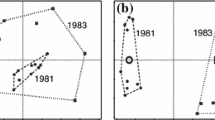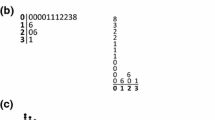Abstract
A modification to a previously described maximum likelihood approach to non-linear ordination is presented. It involves weighting quantitative measures of species importance to ensure that changes in values along a gradient are given equal weight irrespective of their magnitude. The maximum likelihood method was tested with artificial data based on a model incorporating various types of non-linear species responses. Symmetrical and asymmetrical response surfaces, with and without central depression, were used and the method was shown to be reasonably robust. In tests on both real and artificial data it proved superior to other methods.
Similar content being viewed by others
References
Austin M. P. 1976. Performance of four ordination techniques assuming three different non-linear response models. Vegetatio 33: 43–49.
Austin M. P. 1980. Searching for a model for use in vegetation analysis. Vegetatio 42: 11–21.
Austin M. P. & Austin B. O. 1980. Behaviour of experimental plant communities along a nutrient gradient. J. Ecol. 68: 891–918.
Beals E. W. 1960. Forest bird communities in the Apostle Islands of Wisconsin. Wilson Bull. 72: 156–181.
Bray J. R. & Curtis J. T. 1957. An ordination of the upland forest communities of southern Wisconsin. Ecol. Monogr. 27: 325–349.
Burr E. J. 1968. Cluster sorting with mixed character types. I. Standardization of character values. Aust. Comput. J. 1: 97–99.
Goodall D. W. & Johnson R. W. 1982. Non-linear ordination in several dimensions. A maximum likelihood approach. Vegetatio 48: 197–208.
Gower J. C. 1971. Statistical methods of comparing different multivariate analyses of the same data. In: Hobson F. R., Kendall D. G. & Tautu P. (eds), Mathematics in the archaelogical and historical sciences, pp. 138–149. Edinburgh University Press. Edinburgh.
Hill M. O. 1973. Reciprocal averaging: An eigenvector method of ordination. J. Ecol. 61: 237–249.
Johnson R. W. & Goodall D. W. 1979. A maximum likelihood approach to non-linear ordination. Vegetatio 41: 133–142.
Noy-Meir I. & Austin M. P. 1970. Principal component ordination and simulated vegetation data. Ecology 51: 551–552.
Swan J. M. A. 1970. An examination of some ordination problems by use of simulated vegetation data. Ecology 51: 89–102.
Author information
Authors and Affiliations
Rights and permissions
About this article
Cite this article
Goodall, D.W., Johnson, R.W. Maximum-likelihood ordination — some improvements and further tests. Vegetatio 73, 3–12 (1987). https://doi.org/10.1007/BF00031846
Accepted:
Issue Date:
DOI: https://doi.org/10.1007/BF00031846




